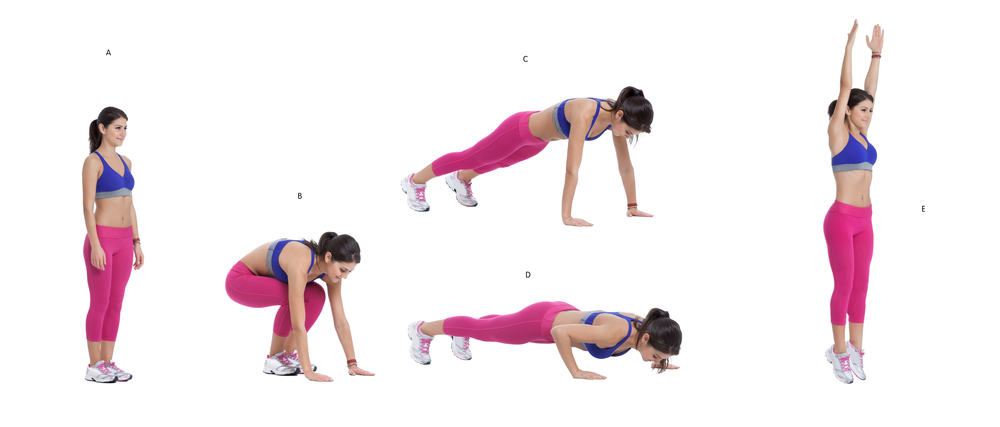Most personal trainers HATE burpees and spend an inordinate amount of time complaining about them. But they have been used in boot camps and fitness classes for years. Should you add burpees to your boot camp workouts? Or avoid them?
Burpees are an ideal exercise for boot camps. They are easy to teach, can be progressed or regressed easily, and they require little space and no equipment. However, as an instructor, you must ensure that you are teaching the correct technique.
In this article, we will take a look at the burpee exercise in detail. We will weigh up the positives and negatives and help you to decide for yourself whether burpees are right for you or not.
What are Burpees in Boot Camp?
Burpees are a form of full-body callisthenics (body weight exercise) that are often used to increase your cardiovascular fitness and burn calories. They can be used as part of the warm up, or as part of the session.
Burpees are often treated like a hardcore exercise, or some sort of punishment exercise, i.e. “last person to reach me does five burpees”. But the reality is that burpees can be as difficult or as easy as you want them to be. It just depends how you progress or regress them.
Are Burpees Good For Boot Camp?
As with any exercise, the burpee is only as good as the person teaching it. Bad burpees are a nightmare. Not only do they increase the risk of injury, but they LOOK bad. A bad burpee will reflect on you as an instructor. This is true of most exercises (squats, push ups etc), but because burpees are so badly thought of by some, a bad burpee will affect your perception more than most.
But a well performed burpee can be an extremely effective movement to incorporate into your sessions. Burpees are simple to learn, require no equipment, and can be edited to match the fitness level of the individual.
Can You Build Muscle With Burpees
As with any exercise, it is possible to build muscle with burpees if you are untrained (haven’t exercised regularly for at least six months). Burpees require you to work your chest, shoulder, and arm muscles. They also target the quads, hamstrings, and glutes.
But they are no substitute for proper resistance training. Burpees are a great introduction to muscle building, but after a while you will need to find other methods to build muscle. Adding a push up into the burpee movement is one way of achieving this.
Are Burpees the Best Conditioning Exercise?
Burpees are a great conditioning exercise. They work the whole body and combine resistance training with cardiovascular training. That does not mean that they are the best though. There are many alternatives that could do a better conditioning job.
However, there are few exercises that are as good at improving conditioning in a boot camp setting. Burpees are one of the most accessible conditioning exercises, making them an excellent choice.
How to do Burpees for Beginners?
Place both hands flat on the floor about shoulder width apart, and get into the typical push up position. Squeeze your abs. Jump forward with both feet so that they are now underneath your shoulders and you are in a crouched position.
From here, you want to jump straight up in the air with your arms raised above your head. Land, and then crouch down before jumping both feet back so that you are in the starting position again.
This is the typical burpee, that is taught all over the world. But it is possible to make it easier or harder depending on your fitness levels and capabilities.
How To Make Burpees More Difficult
If you are finding the standard burpee a little easy, then there are many ways that you can progress the movement. You can add in a push up at the start, so it goes:
- Push Up
- Jump feet forward
- Jump straight up in the air
- Land
- Feet back
- Push Up
Or you could add in a squat, performed just after you land. Or a combination of the two, where you first perform a push up, then a burpee, then a squat.
You can also incorporate plyometrics into it. Perform a burpee, and then go straight into a standing broad jump, or hop, or a plyometric push up. Some instructors add in box jumping, but this is a recipe for disaster – particularly in a boot camp setting!
The truly cruel instructor could even add a plank into the burpee. Starting off with a 20 second plank will make the exercise more challenging but will also slow it down. This variation would be ideal as a finisher move toward the end of the session.
Of course, these progressions should only be performed by boot camp members who are fit enough to do so. There is no benefit to rushing people into these progressions when they are not ready.
9 Burpee Variations
How to Make Burpees Easier
If your members are struggling to perform burpees properly, then it might be an idea to make them easier to do. Slowing the movement down is a great way to do that, but you can also remove the jumping. Without the jumping, this exercise becomes much less challenging and is naturally slower to perform.
Walking your feet forward instead of jumping forward will save a lot of energy and standing up instead of jumping up will also reduce difficulty.
How Not To Do Burpees When Overweight
Being overweight does not necessarily mean that you are unfit. There are many athletes who are overweight but still fitter than the average person (forwards in rugby for example).
Carrying more weight, means that bodyweight exercises are going to be more difficult, as you have more resistance. So overweight clients should avoid the more difficult progressions until they are fit enough to handle them.
More weight also means more pressure on joints and tendons. So avoiding the plyometric aspects of burpees is a good idea. Stand up rather than jump up. Walk forward rather than hop forward etc …
Every client is different, and we don’t want you to group people by their weight. But if you have overweight clients (and what boot camp doesn’t?) you need to be aware of the extra effort/injury risk that excess body fat can bring with it.
What to Look Out for When Teaching Burpees
Avoiding injury is crucial to your success, while it is impossible to completely eradicate it from exercise, there are many things that you can do as a coach to help reduce the risk. Here are several things to look out for when teaching burpees:
- Fatigue – Almost all of the following factors are caused by fatigue, or at least exacerbated by it. If a client looks exhausted before they even start, then consider regressing the movement and slowing the pace.
- Dropped Hips – The starting position for a burpee is similar to a push up, check a client’s hips are in the right place before they begin. Ideally, there should be a straight line from the shoulder to the ankle.
- Rounded Back – When returning to the floor, many clients may round their back rather than squatting down and getting into position. This is usually due to tiredness and subconsciously trying to make the exercise easier. Not only does it NOT make the exercise easier, but it can put a lot of strain on the lower back.
- Chest Bounces – This is an odd one, but from time to time you’ll get a client who fully drops their chest all the way to the floor during a burpee. This can look like they are just enthusiastic, but again, it is about subconsciously trying to make the exercise easier. Using the momentum of the bounce to restart the exercise. It goes without saying that chest bounces are going to increase injury risk.
- Curved Back – This is the opposite of a rounded back and is related to the dropped hips issue we mentioned earlier. In this scenario, not only are the hips dropped but the back is curved. This usually happens after a few reps and can lead to lower back injury if it continues.
If you want burpees to be a feature of your workouts, then you need to ensure that you are checking for these common mistakes. They are very obvious, which is good news for you as a teacher. But bad news if you ignore them! Luckily, it is easy to fix the issues.
Once your clients know what the issues they have, yelling “hips!” or “back!” can be all the coaching they need to reset.
Alternatives to Burpees
While we are big fans of properly taught burpees, there are some boot camp members who are not quite ready for them yet. Here is a quick list of alternatives to burpees that you can use instead.
- Body Get Ups – Body get ups are similar to burpees, but easier to perform. The beauty of this exercise is that you can make it as difficult as you want just by increasing the tempo at which it is performed. Stand upright with feet shoulder width apart. Then lower yourself to your knees and then lie face down on the floor. The moment you touch the ground you can start to rise back up again. Simple huh?
- Jumping Jacks – Obviously, jumping jacks are different to burpees, but if you have a boot camp member who struggles with the getting up and down aspects of burpees then jumping jacks are a good alternative.
- Squat Jumps – If you have a boot camp member who can’t use their arms/shoulders for whatever reason (injury, mobility issues) then squat jumps are a great alternative to burpees. Squat down normally, then jump straight up in the air, land in a crouched position and restart.
Should You Add Burpees to Your Boot Camp Workouts?
Don’t listen to the negativity, burpees are a great exercise choice. The ability to progress them or regress them makes them ideal for large group classes. They can also be edited to help avoid tedium. Just ensure that you teach burpees correctly, look out for bad form, and do not overdo them.
Relying too much on burpees is often perceived as lazy, and while this is an unfair criticism, perception is important when trying to attract new members to your classes.
If you want your boot camp to stand out, you need to be more creative than the competition. Do not fill your sessions with endless burpees, but don’t avoid them either.
Here's a Burpee bootcamp workout to try with your group.
For more exercise ideas for your boot camps, why not check out the Workout Design Club. You'll find lots of different exercises ideas, plus over 2200 group fitness workout formats.
Have You Tried Our Group Fitness Workout Builder?
The Workout Design Club is a group fitness search engine that lets you create stunning group workouts lightening fast.

